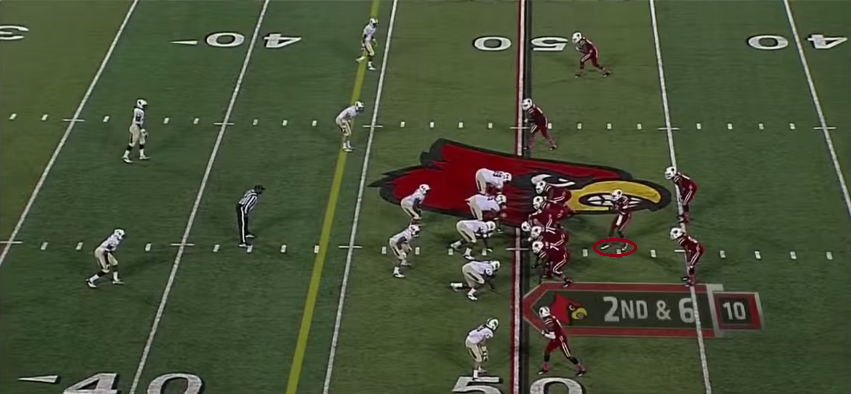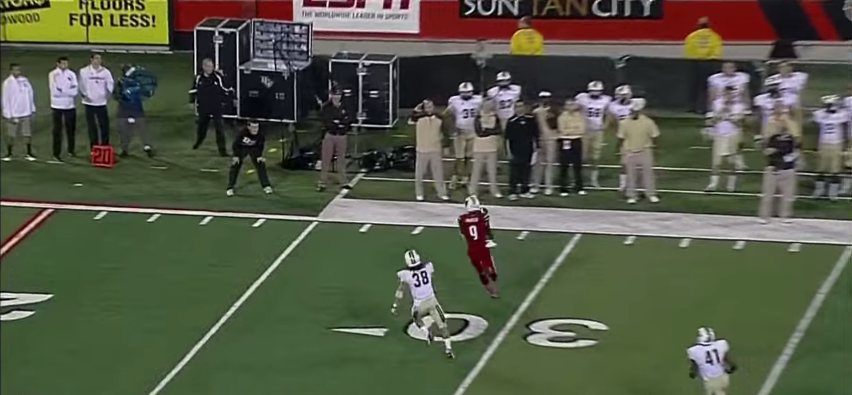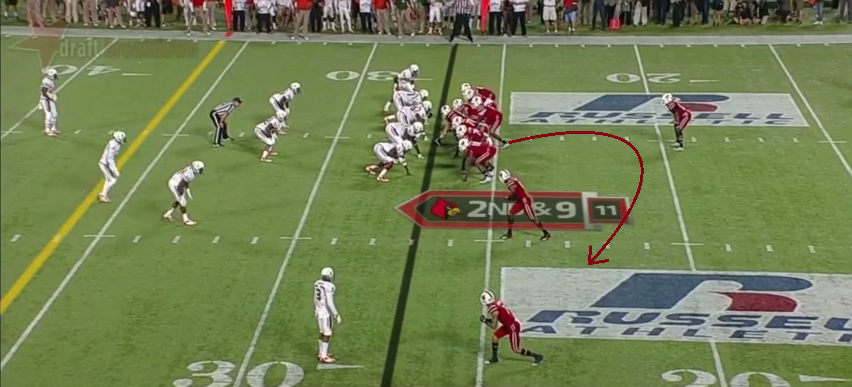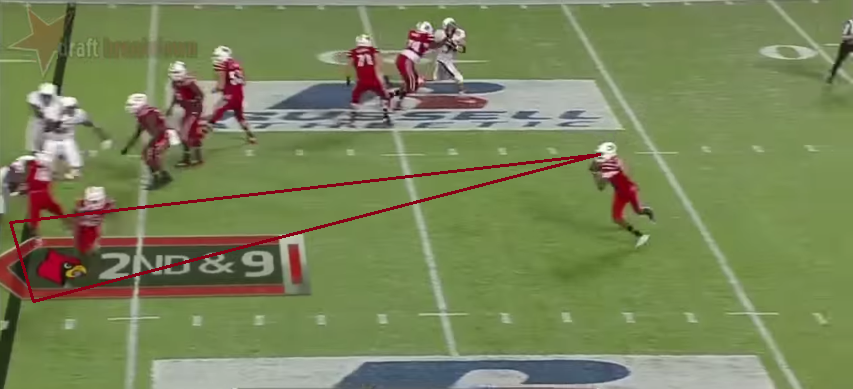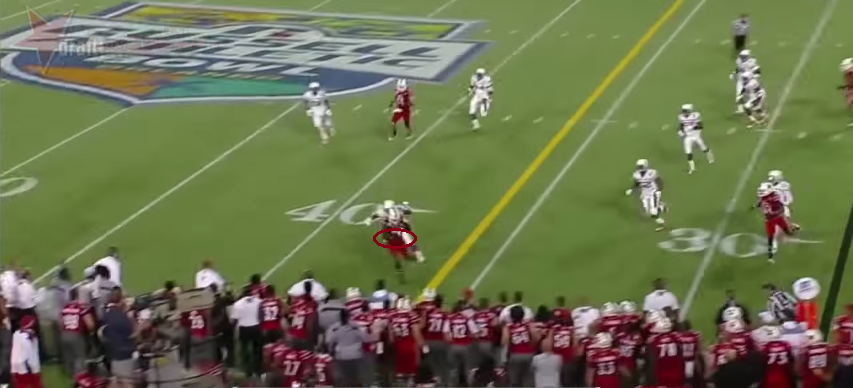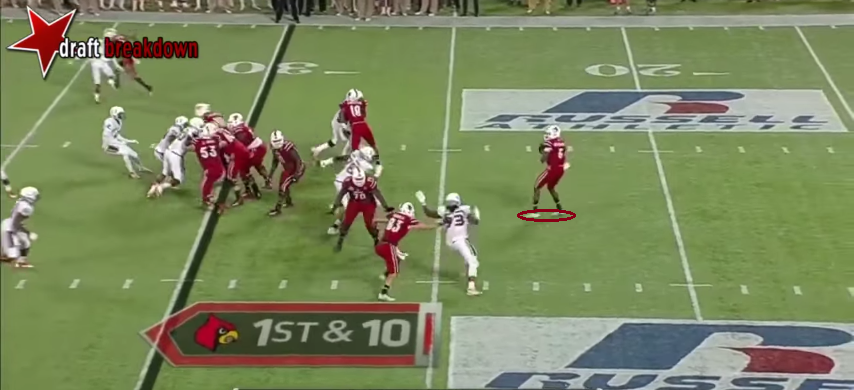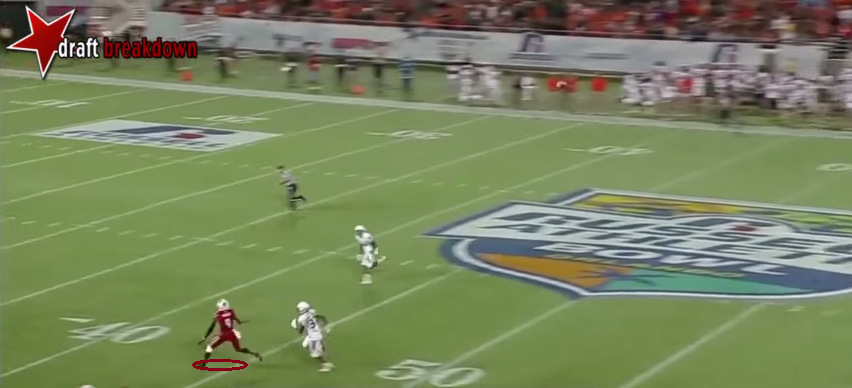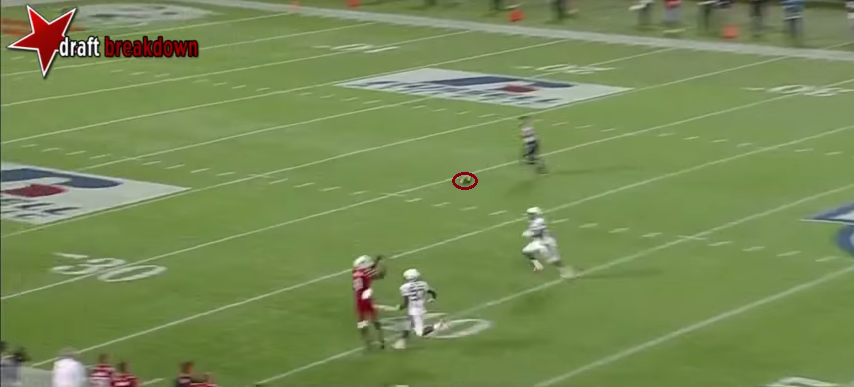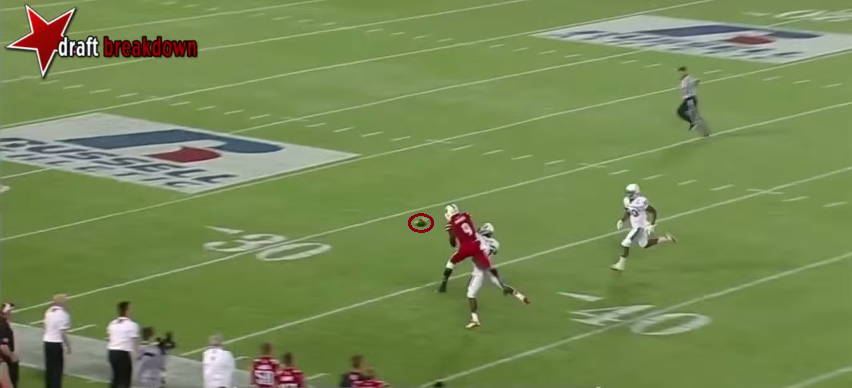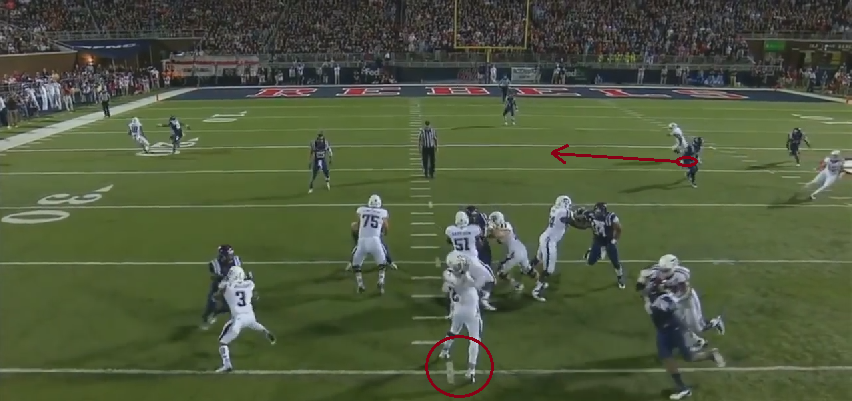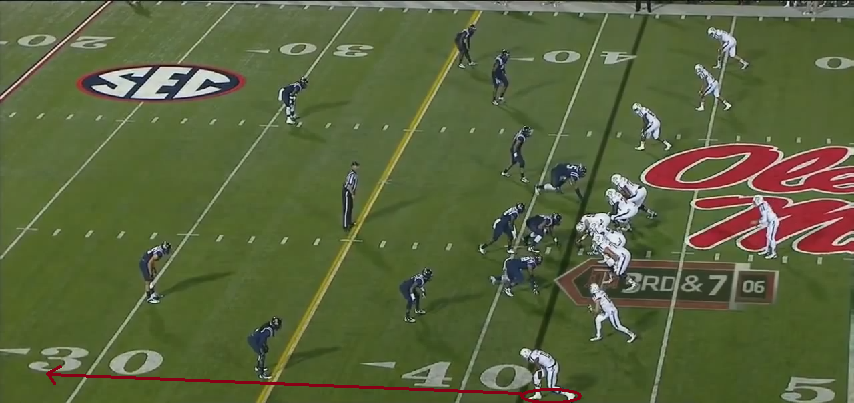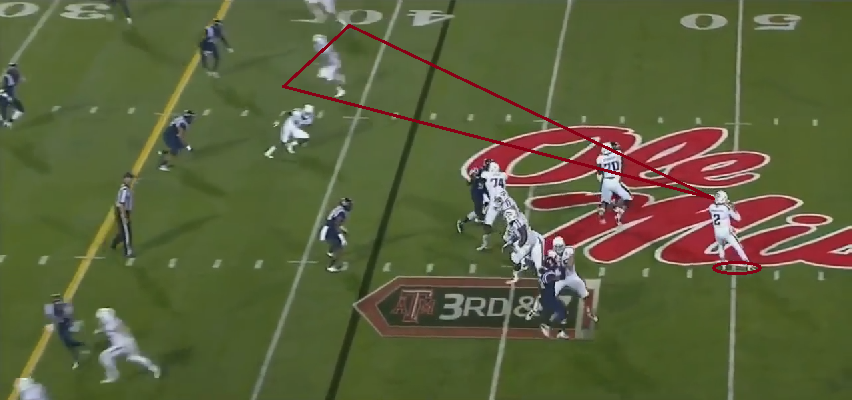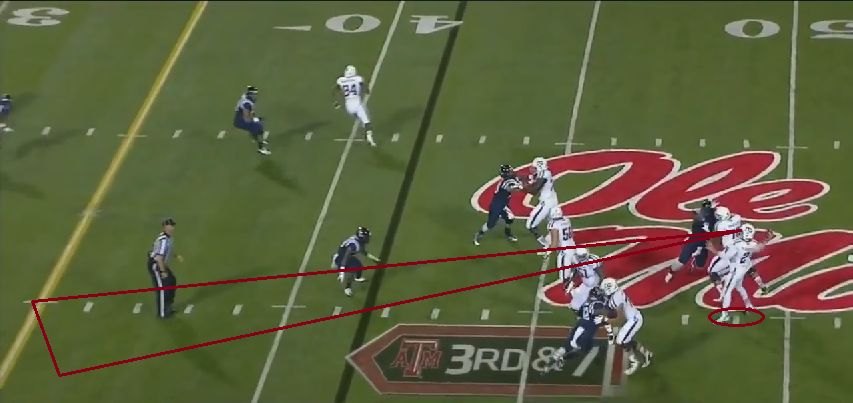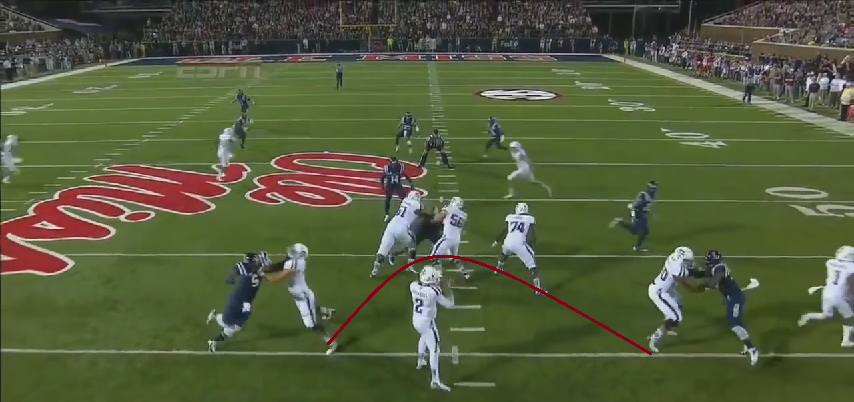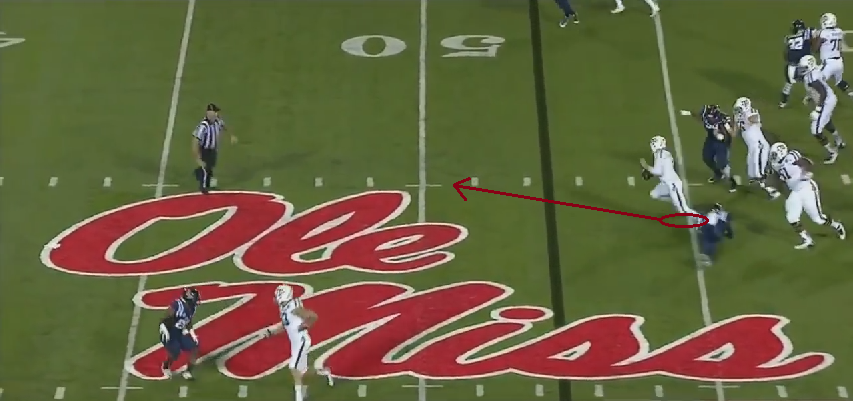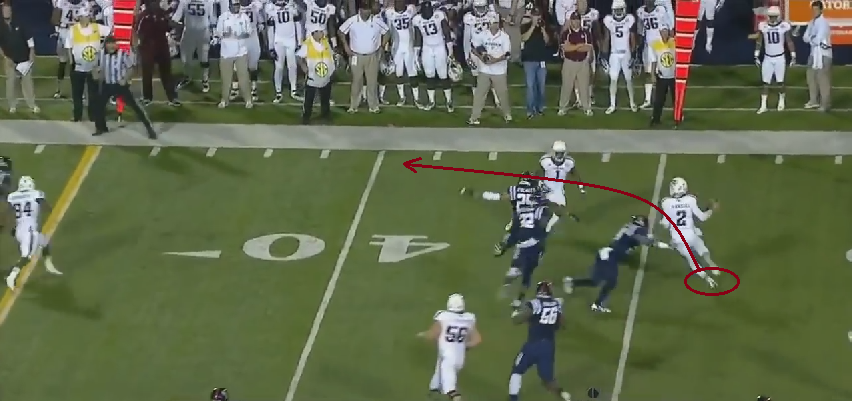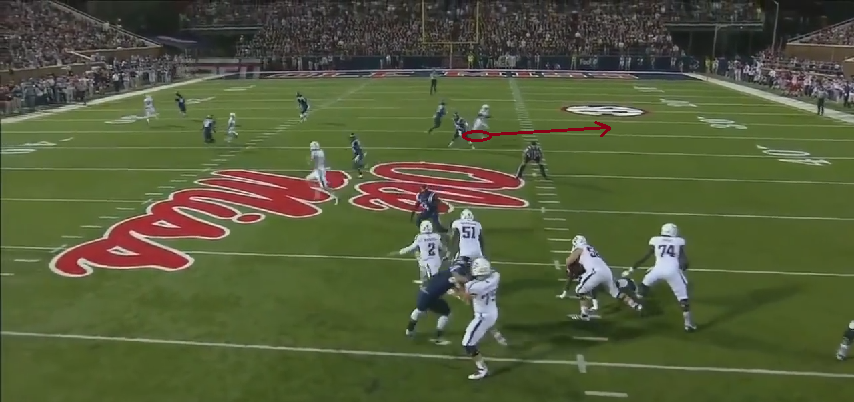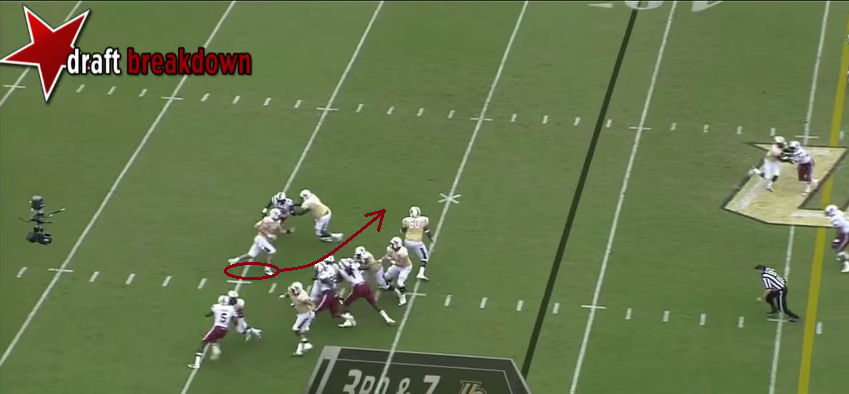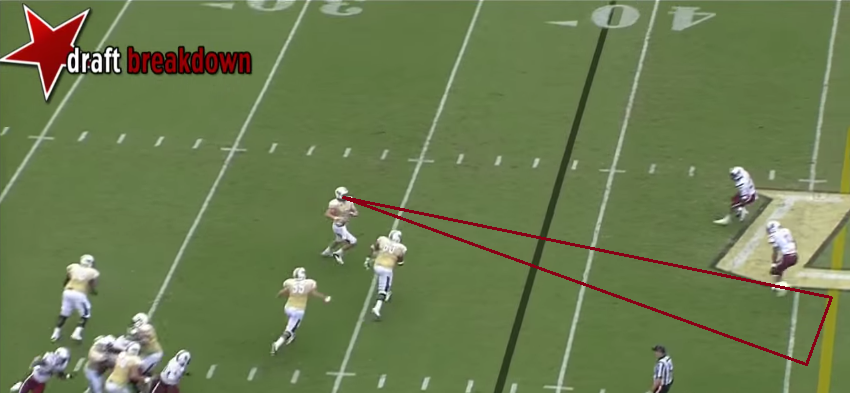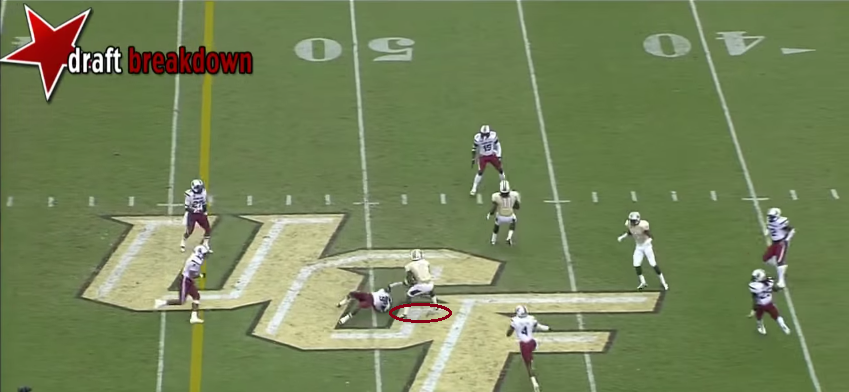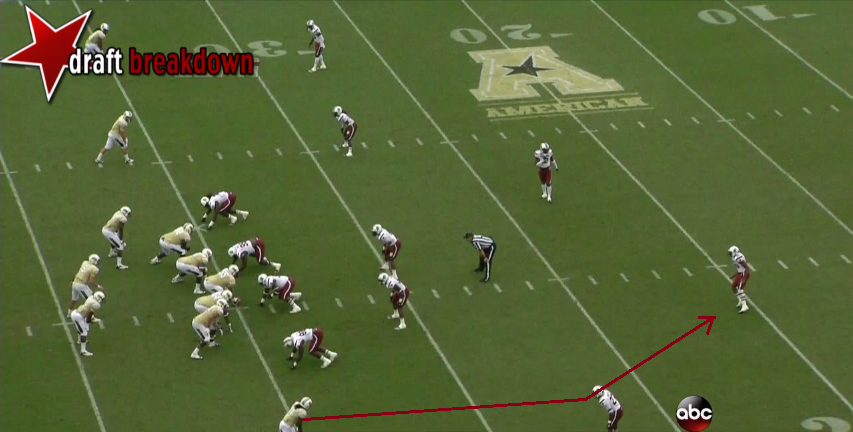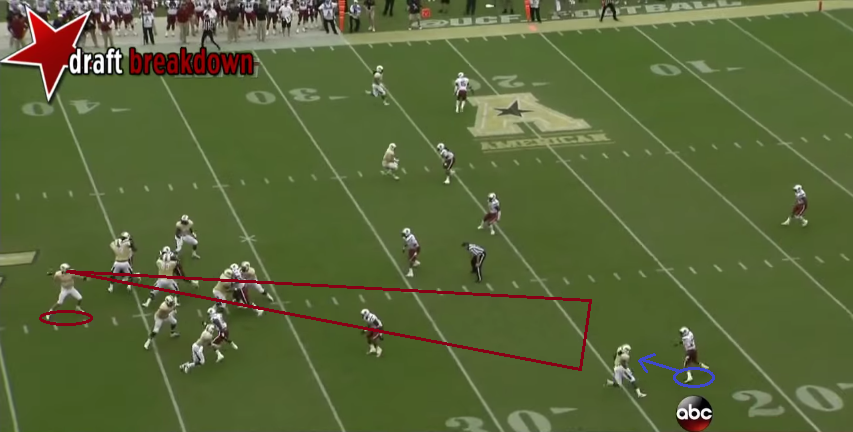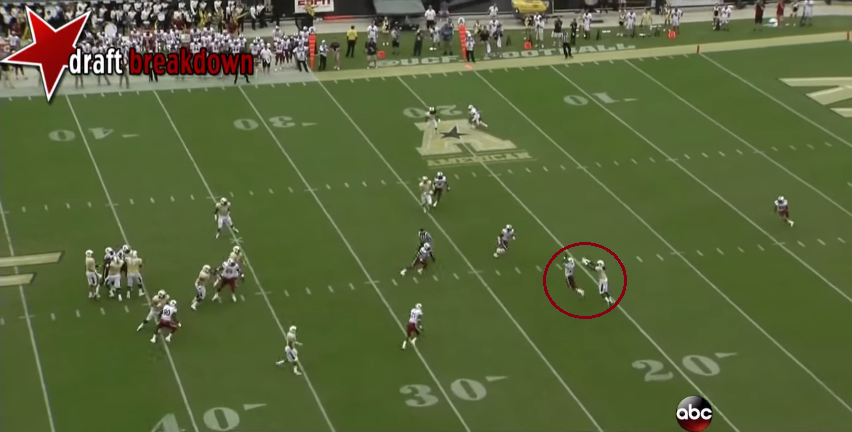2014 Quarterback Breakdown
I have Teddy Bridgewater as my top quarterback in this class. He might not have the ‘wow’ factor that a Johnny Manziel brings to the table, but he does a lot of the overlooked things very well. Playing in a pro-style system has benefited him greatly. I saw him on numerous occasions walk up to the line, change the protection or the play, something which plenty of NFL quarterbacks struggle with.
This play was a fantastic all-round play from Bridgewater that could easily get overlooked. He walks up to the line and changes the protection based on his read on the defense.
His offensive line adjust and pick up the blitz, but his right tackle is struggling to contain the block on the edge. Bridgewater calmly and almost causally takes a few steps to his right to avoid the rusher.
The entire time, Bridgewater keeps his eyes downfield on his targets, making progressions. He could have easily just taken off running for the first down marker here, but instead spots a receiver running open downfield.
He effortlessly throws an accurate pass 20 yards downfield while on the run, hitting his target in stride for a first down and a big gain.
Throwing on the run is something Bridgewater was asked to do plenty of in college. One of the tougher throws for a quarterback to make is while running to their left.
Here, Bridgewater is running a play-action bootleg to his left.
He gets his head around quickly coming out of the fake and starts to make his reads.
This can be an incredibly ackward throw, but Bridgewater makes it look easy. He squares his shoulders to the target, gets his feet positioned correctly and calmly makes the throw.
The accuracy is perfect from Bridgewater, hitting his receiver right between the numbers for an easy catch and another first down.
Plays like that are extremely common in the NFL, particularly in west coast offenses, which suit Bridgewater’s strengths best. Being able to make those kind of plays help keep the offense moving and stop the defense to overcommitting to the run. Teams that have a strong running attack already in place will like what Bridgewater brings to the table.
One of the few knocks I do have on Bridgewater is his deep ball. I don’t think he has a huge issue with arm strength, as he displays plenty of velocity when he needs it. I think he can misjudge just how much he needs to put on the ball and where he needs to be placing it when throwing deep.
On this play, Bridgewater looks to throw a deep ball to his left.
His receiver has a good yard or two on the corner, with the safety struggling to make up ground as well. A good throw here and the receiver potentially has a touchdown.
But Bridgewater doesn’t put enough on the pass, forcing the receiver to stop and come back to the ball.
That allows the corner to make up ground and break up the pass.
The deep ball is something Bridgewater is going to need to work on. He’s more suited to working a west coast system based on short and intermediate passes that move the chains. But he’ll need to prove he can hit the homer run ball when he needs to, otherwise defenses will play their safeties closer to the line of scrimmage and make the underneath throwing windows a lot tighter for Bridgewater.
Overall though, I still see Bridgewater as the best quarterback in this class. He’s much further along in his development than any of the other top quarterbacks, which is partially down to the system he played in at Louisville. The team that drafts him can be happy knowing that he’s ready to slot in and start from day one.
Manziel is easily the most debated name in this years NFL draft. He’s the prototypical boom or bust prospect. He a complete wildcard in team evaluations. Some teams will think he has too many problems to overcome, while others will think they can maximize his upside.
I see two main problems with Manziel’s game; his footwork and his running instincts. Lets start with the footwork, which at times is almost non-existent.
Here Manziel is given a clean pocket. He has a receiver crossing over the middle of the field.
Without any real threat of being hit, Manziel fails to set his feet and throws off his backfoot, almost jumping to throw the ball.
That makes it hard for Manziel to get much velocity on the throw. It dies on him and the receiver has to reach down and practically pick it up off the floor to make the catch.
That was a wide open throw that you’d expect every quarterback to make easily, but because Manziel fails to set his feet correctly, he nearly misses it. But some coaches may believe they can fix that footwork. Manziel has shown that he can get the job done despite having poor mechanics.
On this play, Manziel will end up throwing the deep go route to his left.
But he starts by looking to his right and reading the defense. He then looks down the middle to check the safeties.
Before progresses to his left and pulls the trigger. You can see in this throw, he’s still leaning back, not properly transferring his weight over his front foot.
But he still manages to place the ball perfectly on the back shoulder of his receiver, where only the receiver can make the play.
Manziel has taught himself to get by without the correct footwork. But without it, his passes can look very floaty and not have much velocity on them, or can die on him and fall short of the receiver like we saw above. If a quarterback guru (say, Texans Head Coach Bill O’Brien) thinks he can fix the footwork, then Manziel becomes a lot more attractive to that team.
The other main problem I have with Manziel is also partially what makes him such a unique prospect; his running instincts. Watch any Manziel highlights package and you’ll see play after play of Manziel running all over the place, avoiding defenders and making big plays with his legs. Making plays with his legs aren’t a problem. The fact he’s able to elude defenders and buy more time is actually a huge positive. But what he can’t allow to happen is what happened on this next play.
Manziel is given a clean pocket to work with on this play. He’s under no real pressure and has time to work through his progressions.
Manziel doesn’t see any receivers open, so takes off running. The defense actually have a man set to spy Manziel and come up to tackle him should he start running. Manziel makes a cut similar to that of a running back to completely elude the defender and runs into the open field.
Manziel manages to avoid more defenders before he eventually steps out of bounds for a nice gain. A solid result on the play. However, if we look back at the point he started to take off.
He had a receiver running wide open right past the deep safety. Manziel had no pressure on him in the pocket. If he had stayed in the pocket a fraction longer, he might have seen the receiver running open and had a potential touchdown. But instead, he took off running and missed the open receiver.
This is what Manziel can’t allow to happen. The scrambling ability is a huge positive to his game, but only if he’s not missing open receivers as a result of it. Coaches will be conflicted with this. They won’t want to completely take away the running ability that makes him unique, but they can’t have him missing open receivers down field.
This is what makes Manziel so difficult to evaluate; and what makes him a boom or bust prospect. He has the highest ceiling of any quarterback in the draft, but also the highest bust potential. He’ll need a good coaching set up that will work on his fundamentals and work a system to fit his talents.
To me, Bortles was one of the more disappointing players I have watched this offseason. Bortles has seen plenty of hype, touted as the potential number one pick, but I didn’t see anything that made me believe that hype. To his credit, he is very aware of what’s going on around him in the pocket and displays good pocket mobility to avoid rushers and help his offensive lineman recover on blocks.
On this play, South Carolina move Jadeveon Clowney inside over the right guard. They run a stunt with a blitzer coming in behind Clowney. At the same time, the left tackle is having to deal with a speed rush off the edge. All of this is happening before Bortles even reaches the top of his drop.
But Bortles doesn’t panic and start running around. He remains poised and works his way out of the pocket to elude the oncoming rushers.
Bortles keeps his eyes downfield, finding a target. He does a nice job squaring his shoulders to his target and making the throw.
Which is completed for a first down. This is Bortles best trait. He’s very good at keeping poised and moving in the pocket to keep plays alive while still keeping his eyes down the field instead of on the rushers. He has a very good feel for the pocket, which isn’t something that a lot of college quarterbacks have.
However, that trait alone doesn’t make a prospect worth a top 10 pick. Outside of that, I was very underwhelmed. The scheme he played in wasn’t one that showed off a quarterback ability; it involved a lot of read-option and triple-option plays, as well as bubble screens. It was rare to see Bortles throw the ball down the field. When he did, he had issues with accuracy and bad decisions.
On this play, Bortles has a receiver running a skinny post route against a corner playing off.
As Bortles begins his throwing motion, the corner has already started to jump the route. Bortles is looking straight at receiver, but elects to throw the ball anyway.
The defender is easily able to jump in front of the receiver and intercept the pass. Bortles either didn’t see the defender breaking on the ball, or felt that he could fit the ball in to a window that was shut. Either way, the outcome was a bad interception.
Bortles is a raw prospect in my opinion. He has some qualities that are difficult to teach; poise, pocket awareness and mobility to name a few. But he has a lot to work on and develop to be a consistent NFL starting quarterback. While he’s been touted as a top 10 pick, I would feel much better about him in the mid 20s range to a team trading back up into the end of the first round for a quarterback.
